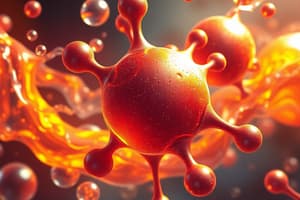Podcast
Questions and Answers
What is the primary characteristic of an acid when dissolved in water?
What is the primary characteristic of an acid when dissolved in water?
- Increases the concentration of hydroxide ions
- Forms salts
- Decreases the pH (correct)
- Accepts hydrogen ions
Which ion is associated with a base when dissolved in water?
Which ion is associated with a base when dissolved in water?
- Hydrogen ions (H⁺)
- Hydroxide ions (OH⁻) (correct)
- Hydronium ions (H₃O⁺)
- Chloride ions (Cl⁻)
What type of reaction involves the transfer of hydrogen ions between acids and bases?
What type of reaction involves the transfer of hydrogen ions between acids and bases?
- Oxidation-reduction reaction
- Substitution reaction
- Neutralization reaction (correct)
- Decomposition reaction
What does a pH value below 7 indicate on the pH scale?
What does a pH value below 7 indicate on the pH scale?
Which substance increases the concentration of hydrogen ions in water?
Which substance increases the concentration of hydrogen ions in water?
On the pH scale, what does a value above 7 represent?
On the pH scale, what does a value above 7 represent?
According to the Brønsted-Lowry acid-base theory, an acid is defined as a species that ____________.
According to the Brønsted-Lowry acid-base theory, an acid is defined as a species that ____________.
The Arrhenius acid-base theory is primarily restricted to ____________.
The Arrhenius acid-base theory is primarily restricted to ____________.
In the Lewis acid-base theory, an acid is characterized as a species that ____________.
In the Lewis acid-base theory, an acid is characterized as a species that ____________.
The strength of an acid is related to its ability to ____________.
The strength of an acid is related to its ability to ____________.
Which theory provides the most general approach to acid-base chemistry and is not limited to aqueous solutions?
Which theory provides the most general approach to acid-base chemistry and is not limited to aqueous solutions?
What defines a base in the Brønsted-Lowry acid-base theory?
What defines a base in the Brønsted-Lowry acid-base theory?
Study Notes
Acids and Bases: A Fundamental Understanding in Chemistry
Acids and bases are indispensable concepts that form the backbone of many aspects in chemistry. Understanding their properties, reactions, and interactions is crucial for navigating the world of chemical reactions. In this article, we'll delve into the essentials of acids and bases, exploring their definitions, properties, and the importance of their classification schemes.
Defining Acids and Bases
Acids and bases are substances that exhibit specific characteristics when dissolved in water. An acid is a substance that, when dissolved in water, increases the concentration of hydrogen ions (H⁺) or decreases the pH. Conversely, a base is a substance that, when dissolved in water, increases the concentration of hydroxide ions (OH⁻) or increases the pH.
Acid-Base Reactions
Acid-base reactions in aqueous solutions primarily involve the transfer of hydrogen ions between acids and bases, leading to the formation of salts and water. Acids can donate hydrogen ions (proton transfer) to bases, while bases can accept hydrogen ions from acids. These reactions are known as neutralization reactions.
The pH Scale and Acid-Base Equilibrium
The pH scale is a logarithmic scale that measures the acidity or alkalinity of a solution. It ranges from 0 to 14, with values below 7 indicating acidic solutions, and values above 7 indicating basic solutions. A pH of 7 represents a neutral solution. Acid-base equilibrium is the balance between the concentrations of hydrogen and hydroxide ions in a solution.
Brønsted-Lowry Acid-Base Theory
The Brønsted-Lowry acid-base theory provides a more general definition of acids and bases. According to this theory, an acid is a species that donates a proton (H⁺) to another substance, while a base is a species that accepts a proton from another substance. This theory is not limited to aqueous solutions and can be applied to non-aqueous systems as well.
Arrhenius Acid-Base Theory
The Arrhenius acid-base theory defines acids and bases based on the production of hydrogen ions (H⁺) or hydroxide ions (OH⁻) in water. According to this theory, an acid is a substance that produces H⁺ in aqueous solution, and a base is a substance that produces OH⁻ in aqueous solution. This theory is restricted to aqueous solutions.
Lewis Acid-Base Theory
The Lewis acid-base theory is a more general approach to acid-base chemistry and is not limited to aqueous solutions. According to this theory, an acid is an electron-pair acceptor, and a base is an electron-pair donor. This theory can be applied to a wide range of chemical systems, including non-aqueous solutions and reactions involving molecules and ions.
Acid Strength and Conjugate Acid-Base Pairs
Acid strength refers to the tendency of an acid to donate protons. Stronger acids donate protons more readily and completely than weaker acids. The conjugate acid-base pair concept describes the relationship between an acid and its conjugate base, which is the species formed when the acid loses its proton. The strength of an acid is closely related to the strength of its conjugate base.
Understanding acids and bases is the first step in grasping a more comprehensive perspective on chemical reactions. These fundamental concepts lay the groundwork for further study in the fields of organic, inorganic, and physical chemistry, as well as biochemistry and environmental science. With this knowledge, you are equipped to delve deeper into the fascinating world of chemistry and its applications.
Studying That Suits You
Use AI to generate personalized quizzes and flashcards to suit your learning preferences.
Description
Explore the fundamental concepts of acids and bases in chemistry, including their definitions, properties, acid-base reactions, pH scale, and acid-base theories such as Brønsted-Lowry, Arrhenius, and Lewis. Understanding these concepts is essential for navigating chemical reactions in various branches of chemistry.




